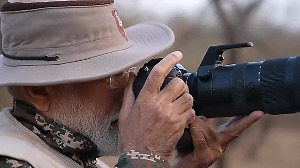The coordinated terrorist attacks on Mumbai, which killed over 120 persons and drew more than a 1,000 security men from the Indian Army, Marine Commandos, the National Security Guard commandos besides the local police to neutralise about two dozen young, well-armed terrorists, is one of the most audacious attacks on India and reveal the maturing of a strongly networked terror coalition with links to terrorist groups based in Pakistan and Bangladesh.
Two other attacks of similar nature were the 1993 Mumbai serial blasts and the December 13, 2001 attack on the Indian Parliament. The latest Mumbai attack, in a way, had operational strategies drawn from both the attacks.
The attacks point at the inevitable expansion of the radical fringe within the 150-million strong Muslim community and the increasing influence of al Qaeda or its allies like Lashkar-e-Tayiba on such men spread out across India, particularly in west and south India.
The involvement of the criminal underworld in Mumbai in carrying out the attacks is strongly suspected. The 1993 blasts were carried out by the members gang lead by Dawood Ibrahim, who now lives in Karachi, Pakistan. Dawood was designated as a terrorist supporter in 2003 by the US government for his links with al Qaeda (sharing his smuggling routes with the terror syndicate). Dawood also financed Lashkar activities, a group suspected to have organised the Mumbai attacks.
The latest series of attacks, carried out by a well-trained, indoctrinated cluster of young jihadis, had other similarities with the 1993 serial blasts and the Parliament attack. The objectives, for instance, were more or less the same.
- Draw international attention
- Cripple the economic hub of the country
- Paralyse the government/political process
- Provoke communal backlash
- Invite more recruits and support for such activities in future
In the Parliament attack, few men, all young, entered the Parliament complex, opened indiscriminate firing and attempted to enter the chamber with the objective of holding political leaders hostage. The 1993 Mumbai blast had targeted some of the well-known landmarks in southern Mumbai, including The Taj and cinema theatres like Metro. There were plans to hold political leaders hostage after entering the Mantralaya (the state secretariat).
Both the attacks had the hand of either Pakistan-based terrorist groups like Jaish-e-Mohammad or LeT or the criminal syndicate led by Dawood Ibrahim, who had the blessings of Pakistan's intelligence agency, the Inter Services Intelligence.
Few conclusions can be drawn about the nature and strength of the group involved in the Mumbai 2008 attack.
1. The number of terrorists involved in the attack (no less than 24) and the high level of coordination and determination they showed in holding ground for more than 30 hours against one of the world's best, and experienced, elite commando force and soldiers point to the involvement of a well-established and highly networked terrorist group or alliance like LeT.
2. LeT has been involved in attacks like the Red Fort attack of 2000, the Parliament Attack of 2001, the Akshardham attack of 2002 and Bangalore IIM attack of 2005 where a modus operandi similar to the Mumbai 2008 attack -- open attack with assault rifles --was used.
3. The terrorists involved in the attack, as in the past cases, are likely to be `volunteers` and not members of the suspect terrorist groups. This is the strategy which al Qaeda has been utilising over the past seven years.
4. The attack was carefully planned, and most likely monitored closely by the masterminds from safe distances. The targets were selected for their visibility, impact, lax security, easy accessibility, hostage taking, and to find convenient fortifications to counter police action.
5. The attack of this magnitude need to be rehearsed and the target locations recceed several times. Most likely, the targets were recceed the morning of the attack.
6. The attack could not have taken place without a local support base, most likely involving the criminal underworld which has a substantial presence in Mumbai.
7. The use of assault rifles and hand grenades point to the involvement of the Mumbai underworld, likely to be the one controlled by Dawood whose association with ISI is well known.
Given these factors and similarities in modus operandi, selection of targets and use of sophisticated weapons and explosives, the involvement of a similar groups with links to ISI becomes highly probable. The suspicion also gathers strength from the role of ISI in carrying out a suicide bombing against the Indian Embassy in Kabul in July 2008. The suicide bomber was a Lashkar operative. LeT has been operating several training camps in North West Frontier Province and Pakistan-Occupied Kashmir where, according to a well-respected Pakistani magazine Herald, recruits, both from Pakistan and other countries, have been training in fidayeen or suicide missions since 2006.
LeT operates a huge empire of schools and charity organisations under the camouflage of a social and religious organisation, Jamaat-ud Dawa from Lahore. LeT chief Hafiz Saeed has been promoting anti-India and anti-Western feelings during his Friday prayers. As recent as October 13, he told his audience that, 'India understands only one language that is jihad'. He argued that, 'India has blocked the water of River Chenab and constructed the Baglihar Dam. Pakistan has failed to stop India from doing so. The only reason is, all this has happened because jihad has been abandoned. India understands only one language ie the language of jihad... jihad cannot be suppressed. In fact, with little support, it can break apart India just like the former USSR.'
The LeT, a pro-Wahhabi group, has been a key instrument of the ISI in sidelining different Deobandi terrorist groups active in India, including Kashmir for the past few years. One of the founding members of LeT has been Abdullah Azzam, a Palestinian jihadi ideologue, more famous as Osama bin Laden's teacher.
Wilson John is Senior Fellow, Observer Research Foundation.






 © 2025
© 2025